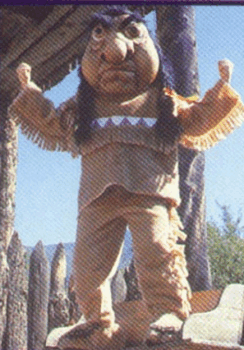
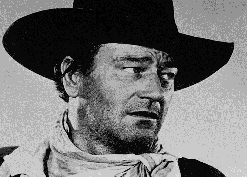 An old article gives an old example of using "Indian Country" to refer to enemy territory:
An old article gives an old example of using "Indian Country" to refer to enemy territory:

 An old article gives an old example of using "Indian Country" to refer to enemy territory:
An old article gives an old example of using "Indian Country" to refer to enemy territory:
News From Indian Country 3/15/1991 V.V; N.3 p. 1
Word Count: 1711
Author
DeMain, Paul
Article
Indian community demands apology from insulting remarks made about enemy territory by Brig. General Richard Neal
(ICC) -- While troops began the long trip home from the Middle East conflict and home town communities prepared for their heroes' return, some members of the American Indian community were still reeling with anger when Brig. General Richard Neal described enemy territory as "Indian Country" February 18th during the height of Desert Storm preparations.
And with several thousand American Indian troops and their communities supporting the joint allied effort the spector that the high military command was using this reference on a regular basis as part of military lingo, the pain of human sacrifice came even harder.
According to Pentagon transcripts in Washington D.C. and the Military Command Joint Information Bureau in Riyadh, Saudi Arabia, Marine Brig. Gen. Richard Neal referred to Iraqi-held territory in Kuwait as "Indian Country" when reporting the rescue of an F-16 pilot Feb 17.
The Broadcast was televised nationwide.
Neal said soldiers with a joint search and rescue unit went 40 miles into Kuwait to rescue the pilot, who had parachuted out of his plane.
"We planned for and executed the recovery. It was, as I said, 40 miles into Indian Country and they did a superb job and there was one happy camper of a pilot when he got back to a safe base," transcripts quoted Neal as saying.
Indian groups around the United States angrily demanded an apology for the Marine general's reference.
Indians have fought and are fighting for the United States and "by God you still get this kind of...from the leaders," said Wayne Ducheneaux, president of the National Congress of American Indians which represents 500 Indian tribes and organizations in the United States.
Ducheneaux, a member of the Cheyenne River Sioux tribe in South Dakota, said the National Congress of American Indians was seeking an apology from military leaders for the "ignorant and insensitive" comment.
Lt. Col. John Tull, a spokesman for the US military Central Command in Saudi Arabia, said "Indian Country" is a term that was used in Viet Nam to mean hostile territory. "I am not exactly sure where it originated. If you think in common sense terms, where might it have come from? From the days of the Wild West and something like that," Tull said.
Another Bureau spokesman, Captain Scott also said he remembered the comment quite clearly because it was a term he had heard in the Viet Nam War as well.
Tull and Scott both said Neal was unavailable for comment.
Indian Country has no official definition in military manuals, said Pentagon spokeswoman Michelle Rabayda in Washington, D.C.
But some people believe otherwise.
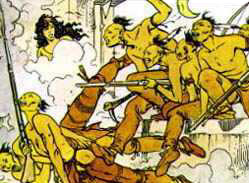
"If you think of West Point Academy and the training that military commanders would have to undertake, you have to ask, what was the original reason for the establishment of the Academy in the first place," said Steve Dodge, a member of the Oneida Tribe.
"It was for the fighting of Indian wars. I doubt if he stumbled and that's the reason why Neal could say "Indian Country" without batting an eyelash...it's an institutionalized term, hostile territory — Indian country, they both mean the same thing in military terms," said Dodge.
According to Dodge "If you look at Indian warfare, and its study which military commanders would have too, you'll find that Indian warfare represented the most extensive type of warfare that has occurred in the world.
"You have guerrilla warfare, jungle warfare, desert warfare, horse warfare frontal attacks and sweeps. In fact Indians were experts in use of the geography as a tool of war and killing soldiers simply by use of the geography," said Dodge. "Even their military hardware is hostile...Tomahawk missiles and Apache Helicopters...why Indian Country brings color to the whole thing."
According to Dodge some of that technology and knowledge inventoried by the military has been exported in recent years to subdue Native populations tactically, militarily and socially in South America.
Ducheneaux said if U.S. military leaders considered enemy territory as Indian country, Indian soldiers shouldn't be asked to fight.
"I think George Bush should make the apology. He is the commander-in-chief of the armed forces. He is responsible for their actions," Ducheneaux said.
Margaret Cooper, of the Lac Courte Oreilles band of Chippewa in Wisconsin, said a group that raised money to build a memorial to Indian veterans on her reservation is also seeking an apology for Neal's comment.
"We as Indian people take one step ahead and negative comments set us back 10 steps economically, socially and politically," she said. "It is time that lingo is not used anymore. You don't realize how it hurts us."
Sam Brushel, a Mohegan who owns the American Indian Shop in Milwaukee, said he was outraged when he heard the remark on television during the daily briefing.
"Obviously it was a freudian slip. It only shows the deep root of prejudice," said Brushel, 53, an Army veteran. "If I was over there and serving, I would have thrown my rifle down and walked away. If there would have been anti-Semitic slang, you would have heard from 40 countries."
Laura Waterman Wittstock, president of Minneapolis-based Migizi Communications Inc., an American Indian news and education organization, called the term "extremely racist," particularly in light of Indian history.
Wittstock said the war is filled with "super macho chauvinistic language," such as Iraq calling it the mother of wars. In peacetime, the propriety of some remarks would be questioned, she said.
Attorney John Beaudin of Madison, a Viet Nam veteran, said that the lingo was not just confined to calling enemy territory "Indian Country" but that he had heard commanders talking about the enemy as being "Indians" as well.
It is part of the same old mindset said Beaudin, "Gooks, Japs, Indians, and other terms that basically diminish the human nature of other people," he said. "We're going to go get ourselves some Indians today," said Beaudin, without thinking at all about the fact that there were Indian people ready to give up their lives for them and this country.
Beaudin said the terms used were racist and belittling and that he had gotten into arguments about their use when he was in the service.
Native American pueblo officials in New Mexico expressed anger at the Marine general's remarks as well
Tony Martinez, operations manager for the Eight Northern Indian Pueblos Council, called the reference racist. "It indicated that American Indians are unpatriotic," said Martinez, a member of Taos Pueblo in northern New Mexico.
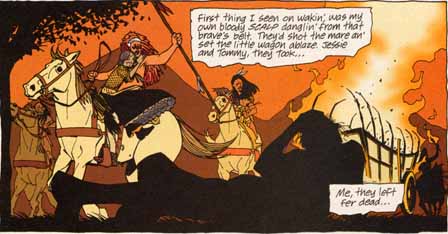
"Those are comments that reflect the John Wayne mentality," he said. "The U.S. government is still fighting against the Native Americans who they consider as enemies."
At last count two American Indian soldiers had died during Operation Desert Storm.
Santa Clara Pueblo Gov. Walter Dasheno, a Viet Nam veteran, said comments such as the general's are personally offensive and destructive to the self-esteem of the 2,400-member pueblo.
"I think the mentality...is real unfair to our Native American Indian people who are part of the crisis," Dasheno said. "As we all know, Indian people have always been supportive and volunteered or been part of the armed forces from the time they've been asked to serve their country."
Martinez said he became familiar with that remark and others when he served in the military during the Viet Nam War.
"They also said `circle the wagons' — it means protect yourself from the savages. The whole irony is, I don't think you'll find Native Americans burning draft cards or fleeing to Canada."
Sandia Pueblo tribal administrator Malcolm Montoya suggested military leaders ask Indian soldiers how they feel about the reference.
"There are a number of service people there (the gulf) from the tribes in this area," Montoya said. "That might not be the best choice of words. I hope such terms would not be used in the future."
In South Dakota, the Cheyenne River Sioux Tribe was seeking an apology from military leaders for the "ignorant and insensitive" words.
But one Indian official reacted with humor.
"My first inclination is to kind of chuckle about it," Navajo Nation press officer Duane Beyal said from tribal headquarters in Window Rock, Ariz.
"I guess there's different ways of looking at it," Beyal said. "On the one hand it's kind of funny....On the other hand, maybe it's somewhat true that battlegrounds are Indian country in that, on a per capita basis, a higher percentage of Native Americans have defended this country in all wars and conflicts."
Beyal said tribal officials have confirmed that 300 Navajo soldiers had served in the Persian Gulf, and he expects the number to climb as the census continues.
"Fighting and battle is a part of the heritage of all Indian people in the United States," Beyal said. "Our people never hesitate to volunteer to serve this country even in World War I. And we weren't made citizens of this country until 1924.
"Maybe the general was confused. Maybe he thought India was somewhere nearby, the same way Columbus was confused.
It's "insulting by its obvious racism," an Arizona lawmaker who is a member of the Navajo Nation, wrote to President Bush.
"With Native American men and women bravely answering their country's call to arms in the Persian Gulf, there can be no room for such comments by their superior officers," Sen. James Henderson Jr. wrote. "To equate the hostile forces of this nation's enemy with Native Americans is intolerable and I hope that, as commander-in-chief, you will take steps to ensure that Gen. Neal is appropriately reminded of this fact."
Henderson, a Democrat, represents a district that encompasses large portions of the Navajo reservation.
Parts of this story came from The Associated Press
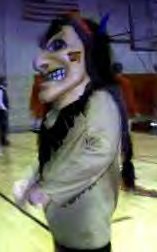
Gulf still "Indian Country"
The problem continues in the war on Iraq:
Indian Country
Beyond the Green Zone in Iraq
by Scott Starr
August 24, 2007
The old tales of the conquest of "Indian Country" are sobering reminders of human folly, delusion, tragedy and hubris that may provide an ominous foretelling concerning the war efforts in Iraq and Afghanistan.
I have in the last few years, since the invasion of Iraq heard a term of military slang or jargon that disquiets me deep down to where the spirit meets the bone. Most people have heard the "safe" area in Baghdad where Americans and their allies have created forts referred to as the "Green Zone". I have also heard or read accounts of the area outside the "Green Zone" referred to as the Red Zone—or sometimes "Indian Country".
During the first Gulf War, Brigadier General Richard Neal, briefing reporters in Riyadh, Saudi Arabia, stated that the U.S. military wanted to be certain of speedy victory once they committed land forces to "Indian Country." The following day, in a narrowly publicized statement of protest, the National Congress of American Indians pointed out that 15,000 Native Americans were serving as combat troops in the Gulf. Since General Neal's comment, however, the term "Indian Country" has become military slang that is often used by troops and leaders on the ground in Iraq and Afghanistan. It was also used in the Viet Nam war. I have heard it occasionally used in T.V. news interviews and documentaries with and about military personnel.
You see, beyond the "Green Zone" one encounters a "terrorist"-infested territory—a wilderness as dangerous to the "justice bearing liberators" as the lands inhabited by by "Redskins" with the resistance they offered during the Indian wars—wars that opposed the conquest, the theft, rape, murder and cultural genocide and treaty breaking mendacity of the allegedly Christian colonizers.
This linguistic use of the term "Indian Country" speaks volumes about the intellectual ignorance and dishonesty of many in the United States' self image of the soul of America. It reveals an often willful ignorance of the perception of the rest of the world. It bespeaks of arrogance, hubris, and self imposed paternalism, exceptionalism and imperialism.
On Monday, March 24, 2003 Christian Broadcasting Network's news program CBN reporter Paul Strand, traveling with the Army's Third Infantry Division in Iraq, stated in a dialog with Pat Robertson:
"Everywhere we've gone we have seen artillery ahead of us and then artillery behind and we're getting reports that there's fighting in all of the cities that we've already been through. So I guess if this were the Old West I'd say there are Injuns ahead of us, Injuns behind us, and Injuns on both sides too, so we really don't want to give the enemy any hints about where we are."
As an American Indian I can state unequivocally that this telling catch phrase that projects the warzones of the "wars on terror" as "Indian Country" is as deeply offensive as it is counter-productive to the stated mission in Iraq. My immediate thoughts—the first time that I heard the reference to the war torn streets of Baghdad as "Indian Country"—was that after 515 years of conquest—in the minds of Imperial America—the First Nations of the "Americas" are still regarded as enemies, hostiles, obstacles to progress... as terrorists. "Indians" then, in the American mindscape are yet sub-humans with no intrinsic value and no redeeming qualities and no contribution and/or partnership in contemporary society save as cartoonish sports mascots and fodder for the myth making propaganda of manifest destiny and fantasies of the "master race" as portrayed in Hollywood western movies and literature.
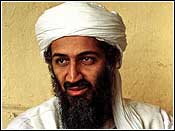

Take heed that this collective psychosis, this self adulation and lack of self criticism that plagues America is well noted by those who oppose us in the bloody streets of Baghdad and in the "Indian Country" of Afghanistan. One can accuse voices such as mine as emboldening the enemy by offering critical analysis of the situation in America's wars in the "Middle East" ("Middle East" being another colloquialism coined from the Western perspective of the planet). But—with these not so subtle attitudes couched within the phraseology of "Indian Country"—is it any wonder that they have resolved to fight us to the death—there in their home territory? Is it any wonder that America is seen as invaders, imperialists and controllers rather than liberators? Indian country they call it? Isn't it more likely that the attitude that lies behind colloquialisms like this are what emboldens our enemies and gives them the resolve to oppose the American agenda as they perceive it?
During the conquest of the "Americas"—Indians were reviled as a species that could not be reasoned with and that their extermination was necessary to progress and order. Don't you think its at the least imprudent for Americans to tacitly refer to the people that they are allegedly trying to liberate as "Indians"? The experience of "American Indians"—on their own ancestral ground is a testament, to this very day,to the often racist, dehumanizing and marginalizing power of the blight and rot in America's self indulgent soul. Why would the Arabs in the "Indian Country" of their own homeland desire a status resembling anything like what "American Indians" have experienced?
In 1779, George Washington instructed Major General John Sullivan to attack Iroquois people. Washington stated, "lay waste all the settlements around...that the country may not be merely overrun, but destroyed". In the course of the carnage and annihilation of Indian people, Washington also instructed his general not "listen to any overture of peace before the total ruin of their settlements is effected". (Stannard, David E. AMERICAN HOLOCAUST. New York: Oxford University Press, 1992. pp. 118-121.)
In 1783, Washington's anti-Indian sentiments were apparent in his comparisons of Indians with wolves: "Both being beast of prey, tho' they differ in shape", he said. George Washington's policies of extermination were realized in his troops behaviors following a defeat. Troops would skin the bodies of Iroquois "from the hips downward to make boot tops or leggings". Indians who survived the attacks later re-named the nation's first president as "Town Destroyer". Approximately 28 of 30 Seneca towns had been destroyed within a five year period. (Ibid)
Though America has forgotten, ignored or never internalized the fact that much of its history and many of its god-like heroes like George Washington, the so called father of "our" country are constructed out of pure propaganda and balderdash—the rest of the world is quite painfully aware. Despite Washington's sentiments that the American nation could not be put together so long as the "Indians" existed as "Indians"—it was built... and in case one needs to be reminded... we are still here.
Now, critics of this article will be quick to point out that "American Indians" don't have it so bad these days—what with the casino industry booming and all. Fair enough. For the record, as an "Indian" traditionalist, I do not approve of the smoke shop, tourist trap, bingo parlor/casino culture that is erasing our spiritual legacy and replacing it with the value system of our colonizers and thus detracting from our voice of moral authority and stand upon moral principles. Nobody understands the fallibility of human nature, the power of money, propaganda and politics better than one who maintains their identity as an "American Indian" and also a believer in the true Christ of the Gospels as opposed to that of opportunistic political operatives.
"Indian Country" indeed. The analogy does bring one event from American history to mind. There is another tale of arrogance and hubris that is a sobering and perhaps ponderous and foreboding omen concerning the war efforts in Iraq and Afghanistan. Revisit and contemplate the tale of General George Armstrong Custer and the battle of Little Big Horn. Pride of the kind considered one of the seven deadly sins can carry a heavy toll in "Indian Country".
author—Scott E. Starr
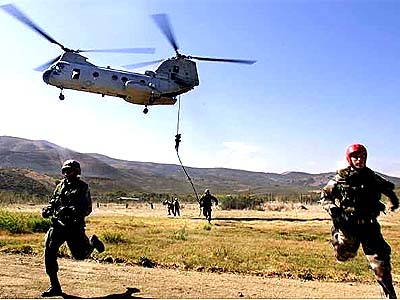
More on the story
From Matthew Richter, editor of American Comments magazine:
Free Fire Zones? "We Called It Indian Country"
JOHNSON: I have heard the free-fire zone referred to by the pilots and other people as "Indian Country."
SEIBERLING: But you are not familiar with the expression "turkey shoots"?
JOHNSON: I am familiar with it, but where I was operating I didn't hear anyone personally use that term. We used the term "Indian Country."
SEIBERLING: What did "Indian Country" refer to?
JOHNSON: I guess it means different things to different people. It is like there are savages out there, there are gooks out there. In the same way we slaughtered the Indian's buffalo, we would slaughter the water buffalo in Vietnam.
Comment: And the same way we slaughtered the Indians fighting for their homelands, we slaughtered the Vietnamese fighting for theirs. The parallels are clear.
Al Carroll's thoughts
Al's reply to my comments on "Indian Country" in Indians in the Military:
There's an article by David Espy called "Vietnam—the Indian Subtext" that talks about these issues. He also discusses:
1) Firebases near VC territory were called "Ft. Apaches."
2) The US Army trained South Vietnam troops using Westerns. They were taught to shout "VC" when the "Indians" appeared onscreen.
3) In John Wayne's "Green Berets" the VC act like Hollywood Indians, war whoops and all.
4) Rambo is consciously "playing Indian" in his appearance, long hair, headband, and wearing native style amulets.
5) Senior military people used the Indian war analogy in testimony before Congress. Gen. Curtis Lemay (the same one who ran as Wallace's running mate. He was also the model for Gen. Jack Ripper in Dr. Strangelove) justified strategic hamlets by saying "You have to keep the settlers away from the Indians."
Tom Holm, who is Cherokee, also discusses this issue in his book Strong Hearts, Wounded Souls on Native vets of Vietnam. Native vets have a much higher incident of being forced into combat by preconceptions of white NCOs and officers, as well as choosing combat and danger in order to prove themselves according to their people's warrior traditions. I've found interviews where Native soldiers trained as clerks were forced into elite combat units, but also plenty of Native vets who chose combat to prove themselves to their communities back on the rez.
There's a term, Super Scout Syndrome, the assumption that all Indians are natural warriors. There was even a study done after WW1 that asserted Indians could see in the dark and always knew which way was north without a compass.
Before WW1, there was an effort by Dr. James Kossuth Dixon, one of the self styled "friends of the Indian," to create permanent cavalry units of Natives who were to become "America's Cossacks." All Indian males were to be required to attend military schools and serve from 18 till 45. It only failed because most white reformers wanted Natives integrated into white units. They believed "war was a civilizer"—BIA Commissioner Cato Sells.
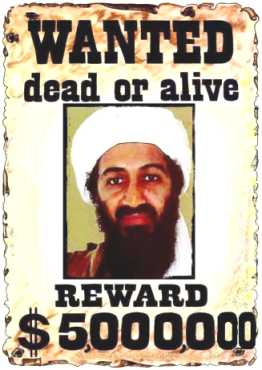
Interesting thing is that association has only emerged in two wars from what I've found, Vietnam and the current one (such as that congressman's comment comparing Bin Laden to Indians). Opponents in the world wars weren't associated with Indians, but US and Canadian troops termed themselves "Indianhead Warriors" (US Army 2nd Division) and so on, in a manner much like sports teams.
Rob's reply
You're obviously way ahead of me, since you've listed the few connections I know and several more.
Perhaps we associated the Vietnamese and Bin Laden's terrorists with Indians because they were exceptionally ruthless. Or perhaps because we suffered a great loss at their hands.
The Viet Cong and Rambo connections are interesting. We often think of Indians as vicious savages (the Viet Cong), but also as noble warriors (Rambo). The polar opposites suggest that maybe Indians and our Vietnamese opponents embodied good and bad. In short, that maybe both groups were people, not faceless symbols.
The comparisons continue
From Our Indian Wars Are Not Over Yet: Ten Ways to Interpret the War on Terror as a Frontier Conflict by John Brown:
1. Key supporters of the War on Terror themselves see GWOT as an Indian war. Take, for example, the right-wing intellectuals Robert Kaplan and Max Boot who, although not members of the administration, also advocate a tough military stance against terrorists. In a Wall Street Journal article, "Indian Country," Kaplan notes that "an overlooked truth about the war on terrorism" is that "the American military is back to the days of fighting the Indians." Iraq, he notes, "is but a microcosm of the earth in this regard." Kaplan has now put his thoughts into a book, Imperial Grunts: The American Military on the Ground, which President Bush read over the holidays. Kaplan points out that "'Welcome to Injun Country' was the refrain I heard from troops from Colombia to the Philippines, including Afghanistan and Iraq.... The War on Terrorism was really about taming the frontier."
Enemies as Indians in the Stereotype of the Month contest
Soldiers vs. Indians again
NY Post headline calls Al Qaeda outpost "Indian Country"
Canadian manual: "Radical" Native organizations = insurgents
Buchanan's Iraq: In "Indian territory" you "get tomahawked"
LA Times article claims "Ramadi [Iraq] is Indian Country"
Christian Broadcast Network: "Injuns" surround troops
Senior US official calls Bin Laden's followers "Indians"
More on enemies as Indians
Soldiers vs. Indians again
Related links
Indians in the military
|
. . . |

|
All material © copyright its original owners, except where noted.
Original text and pictures © copyright 2007 by Robert Schmidt.
Copyrighted material is posted under the Fair Use provision of the Copyright Act,
which allows copying for nonprofit educational uses including criticism and commentary.
Comments sent to the publisher become the property of Blue Corn Comics
and may be used in other postings without permission.